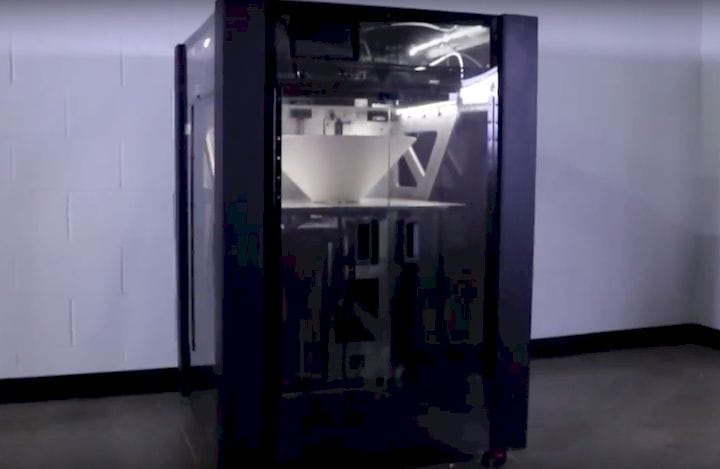![The huge Northworks 600x industrial 3D printer [Source: Northworks]](https://fabbaloo.com/wp-content/uploads/2020/05/image-asset_img_5eb0a50331418.jpg)
We have not yet seen the Northworks 600x 3D printer, but it seems to be an amazing machine.
The Houston-based company provides low-volume 3D print and manufacturing services, as well as a line of two models of very intriguing 3D printers. The Northworks 600x is of most interest, while the smaller 300x model includes most of the features of its larger sibling.
There aren’t that many large-format 3D printers available on the market today, and those that are available tend to have significant restrictions on what materials may be used in them. That doesn’t seem to be the case with the 600x.
The most notable feature is, of course, the build volume. This machine sports a truly massive build volume of 610 x 610 x 914 mm, able to accommodate virtually any conceivable 3D print.
But the company has smartly tuned this machine with a number of features that make this enormous build volume quite practical. For example, the machine is able to perform very precise automatic calibration to reduce print failures. It also is made from a very strong steel and aluminum frame, providing rigidity to match the machine’s rather amazing 0.05mm minimum layer size.
They have equipped the machine with linear rails and dual extruders, which, when combined with the stiff frame and powerful stepper motors, allow 3D printing at very high speeds. They say they can print twice as fast as normal 3D printers, and even list print speeds of 15,000mm/min (250mm/second). This is indeed very fast, but likely achievable only under optimal conditions with specific 3D model geometries.
![Swapping extruders easily on the very rigid Northworks 600x 3D printer [Source: Northworks]](https://fabbaloo.com/wp-content/uploads/2020/05/600x-nozzle_result_img_5eb0a50361183.jpg)
But if they can print faster, that is particularly useful for a large-volume machine where prints might otherwise take days to complete. A seven-day print saving only 15% of time would eliminate a whole day of printing, for example.
They include a fascinating swappable nozzle system that appears to be one of the easier designs we’ve encountered. In their video they simply lift off the extruder mechanism and mount another, likely with some tie down bolts. This allows the machine to use nozzles of up to 1.2mm in size, permitting more material to flow: this nozzle diameter is 9X larger than the standard 0.4mm nozzle.
The Northworks 600x also can use a 0.15mm nozzle, one of the smallest diameters we’ve ever heard of, and it’s for one of the largest machines we’ve seen. This would permit highly detailed 3D prints, but raise the print durations to exceptionally long periods.
Active heating is used in the 600x’s build chamber, enabling successful 3D printing of many more material types. Most other large-format 3D printers use open-style frames that encounter ambient air and thus are restricted to low-warp materials like PLA.
![Applying a thin PEI sheet inside the Northworks 600x 3D printer [Source: Northworks]](https://fabbaloo.com/wp-content/uploads/2020/05/image-asset_img_5eb0a50390288.jpg)
One of the most interesting features of the 600x is its adhesion system, a critical component of any extrusion-based 3D printer, where the first layer must stick or the print fails.
The 600x employs a vacuum plate system, somewhat similar to what is used on Stratasys’ Fortus line, but with some significant differences.
The idea is to lay down a layer of appropriate material to ensure the print sticks. A vacuum system pulls the sheet tight to the rigid metal build plate underneath. This means you can use different types of sheets for different materials. For example, a PEI sheet would be appropriate when printing PLA or ABS, for example, while they recommend plain paper for ULTEM!
This is quite different from Stratasys, who sell you one-time use sheets for their Fortus equipment, and that price adds up over time. The 600x’s “open sheet” approach should be far less expensive.
![Easily peeling off the build sheet from the bottom of a large 3D printer [Source: Northworks]](https://fabbaloo.com/wp-content/uploads/2020/05/image-asset_img_5eb0a503bc462.jpg)
It also provides a very easy way to remove prints: you just peel them off! This could be the easiest way I’ve ever seen prints removed from any 3D printer.
Unfortunately, Northworks does not post the pricing of the equipment and requires you to negotiate with them for a quote. This is reasonable, as the large size of this machine suggests they don’t really have a large pre-made stock of them available in the warehouse and probably build them upon ordering.
Via Northworks











FELIXprinters has released a new bioprinter, the FELIX BIOprinter, which is quite a change for the long-time 3D printer manufacturer.